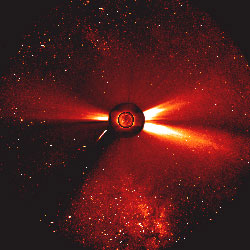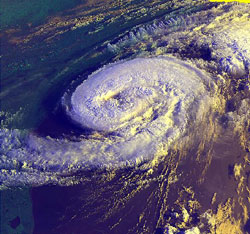Piers Corbyn: "Yes, it is more powerful and reliable than
traditional methods. Traditional forecasts can only go up to ten
days ahead for any meaningful forecast whereas the Solar Weather
Technique can give detailed forecasts of extreme weather many months
ahead. It is proven to be especially accurate for cold snaps and
storms. Traditional forecasters believe that the Earth’s weather
is primarily controlled by weather in the past, which is not true;
there are external influences that come from the Sun, and are predictable."
FS: "Why does no one else use your method?"
PC: "Because it’s a secret! We’ve explained the
general idea of how the technique works using predictable aspects
of influence of solar activity on weather but not how to calculate
them. We have studied hundreds of years of weather activity and
corresponding solar activity such as solar flares and sunspots and
have made our calculations. We attribute confidence levels to our
forecasts and when these are high, as they often are for extreme
events such as major storms, we are accurate over 85% of the time.
Independent assessments by the University of Sunderland agree our
long range forecasts of storms and cold spells are statistically
significant with the chance of them being down to luck being only
one in a thousand."
FS: "What can you tell us about the ‘Solar Weather Technique’?"
PC: "The ‘Solar Weather Technique’ is a procedure
using predictable links between solar activity and weather. Particles
are ejected from the Sun and these particles generate the changes
in solar wind (the rush of particles from the Sun) which allows
us to predict changes in the weather. There are two parallel approaches;
the first one generates Weather Action Indicators. These are theoretical
parameters which describe the Sun-Earth magnetic/particle weather
state. We use these to identify when some predicted future state
occured in the past. We then look back at weather patterns over
the last one hundred years with a time resolution of a few days
and use these parameters to find which weather systems are likely
to occur in the future as a result of predicted solar activity.
The second parallel approach are general predictions and does not
rely directly on specific time windows of past data. The two approaches
are combined to produce the long range forecast."

SoHo
The
Solar wind flows from the sun at up to 900km/s - this stream
of particles may control our weather.
|
FS: "How far in advance can you predict the weather?"
PC: "We issue detailed forecasts (with time resolutions of
a few days) up to eleven months into the future in seasonal batches.
We can issue forecasts for certain events up to two years into the
future."
FS: "Who hires you to predict weather?"
PC: "Many companies in different sectors, but for example,
the energy and travel
insurance industries hire us for long range and medium range
forecasts. Through our predictions they can plan their production
and advertising. Farming and agriculture industries mostly use our
medium range forecasts (up to 14 days) or our 30 day ahead forecasts.
To them these are invaluable tools. Retailers also use our services
because weather triggers the sale of many products and deternines
what people need and so assists in stock control and planning of
anything from soft drinks to car batteries."

NASA
Hurricane
Bonnie over the USA - in a window predicted by the Solar Weather
Technique six months before
|
FS: "What’s the most extreme weather you predicted
recently?"
PC: "We predicted the storms in Southern Britain and Europe
that occurred at Christmas in 1999 nine months in advance. We also
predicted that September 1999 would be "exceptionally active"
for Atlantic tropical storms and super-hurricane Floyd appered on
cue."
FS: "Is global weather changing?"
PC: "Global weather is always changing! There is nothing new
happening that couldn’t be reasonably explained by solar activity.
Substantially bigger climate variations than recent changes have
occured in the last few hundred or few thousand years due to natural
causes. The surface temperatures here on Earth have increased in
the last century but this is more closely correlated with increases
in solar activity than with rising carbon dioxide levels made by
man. The temperature could start to fall shortly or could rise for
another thirty years depending on general changes in solar activity.
I don’t think the long-term predictions of global warming using
carbon dioxide theories mean anything."

NASA
Will
studying changes in solar activity let us know when the next
Ice-age is coming?
|
FS: "Can you predict when the next ice age will be?"
PC: "We don’t know enough at the moment but in principle
it might be possible to predict mini ice ages which involve slow
changes in solar activity over time scales of a few centuries. The
prediction of a Large Ice Age involves other factors such as interstellar
dust and the Earth’s orbital changes, over time scales of tens
of thousands or millions of years. We might be able to develop super-long
climate predictions in the future but this is some way off."
FS: "Do you predict any extreme weather for the near future?"
PC: "We forecast weather for the U.K, Europe and the Atlantic
area. Our long range forecast issued 11 months ago stated that the
U.K can expect major thunderstorms in the second week of may 2000;
these were confirmed as were various other extreme events which
are reported regularly in our Weather Action Bulletin (available
in digital format via our web site). As far as the United States
are concerned, we have made some predictions of Tropical storms
and of summer temperatures and their implications for power consumption
by air conditioning systems."
